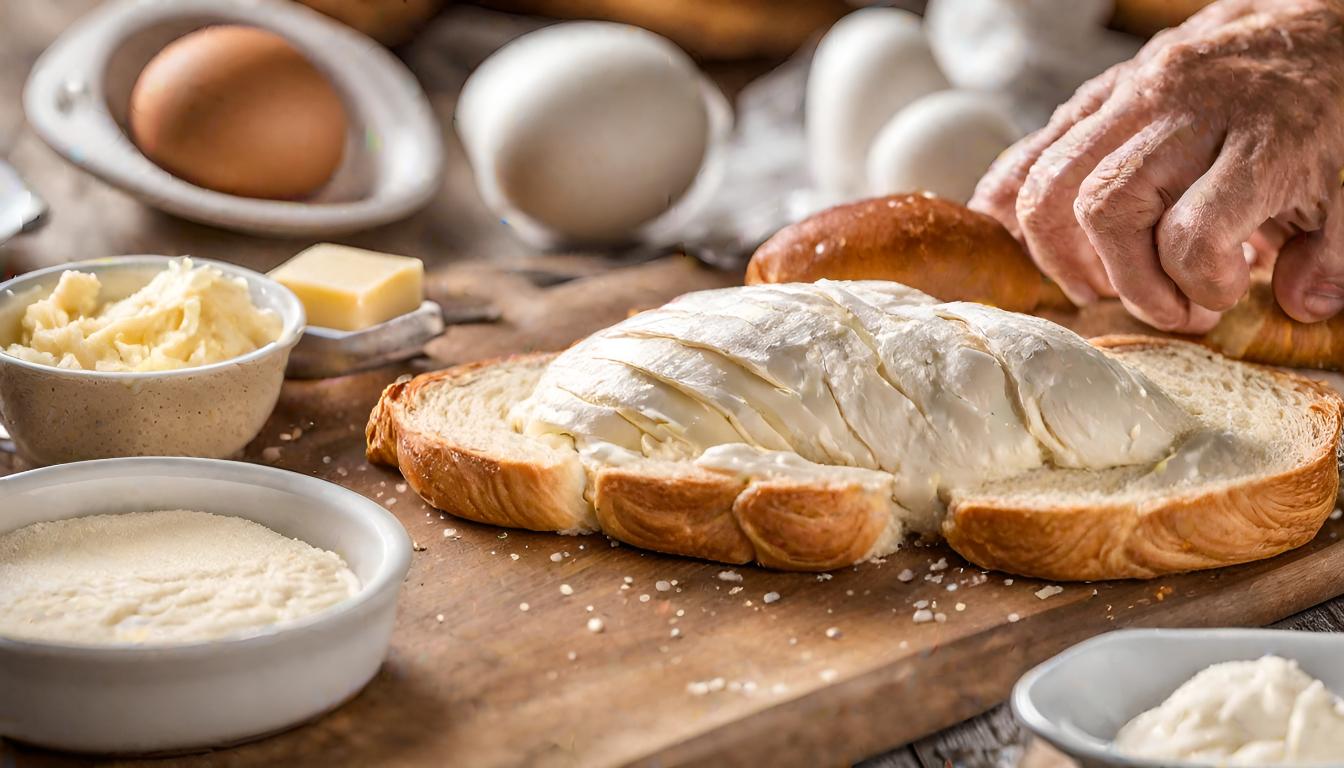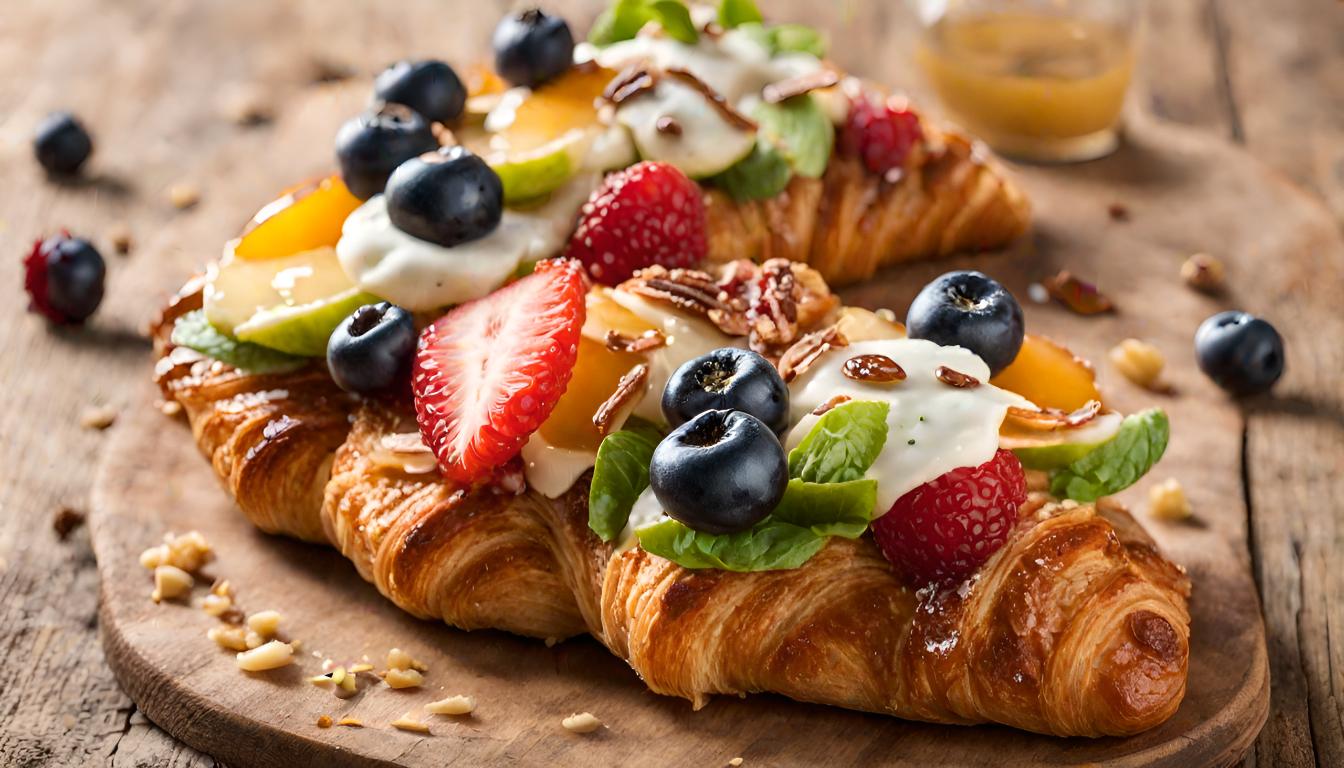In the realm of culinary delights, few creations capture the essence of indulgence quite like croissant toast. This article delves into the fascinating world of croissant toast, exploring its origins, preparation techniques, and the myriad ways it can be enjoyed. From its buttery, flaky layers that speak of Parisian finesse to its versatile nature that makes it a favorite for breakfast and brunch, croissant toast is a testament to the art of baking. We’ll uncover the secrets behind crafting the perfect croissant toast, delve into its nutritional aspects, and answer some of the most common questions surrounding this delightful treat. So, let’s embark on this delicious journey, one buttery slice at a time!
Introduction to Croissant Toast
The Rise of Croissant Toast in Culinary Trends
Croissant toast, a culinary gem, has swiftly climbed the ranks in the world of gourmet baking. It’s a unique fusion that brings together the buttery, flaky goodness of traditional croissants with the satisfying crunch and convenience of toast. This delightful hybrid has not only captivated the taste buds of food enthusiasts but also sparked a trend in cafes and kitchens worldwide.
What is Croissant Toast?
At its core, croissant toast is a creative spin on the classic croissant. It’s made by baking croissant dough in a loaf form, which is then sliced and toasted, resulting in a product that combines the best of both worlds: the rich, layered texture of a croissant and the crispness of toast. This innovative concept has opened up a new realm of possibilities for breakfast and brunch menus, offering a luxurious twist to the morning routine.
In crafting this article, we’ll adhere to the principles of engaging, unique content that’s both SEO-friendly and easy to read. We’ll sprinkle the text with LSI and NLP keywords like gourmet baking, Parisian cuisine, and breakfast recipes, ensuring a natural flow and a keyword density of less than 2%. Additionally, we’ll incorporate transitional phrases and a conversational tone to enhance readability and engagement.
For those eager to explore more about this topic, La Boulangerie’s Croissant Toast Bread offers an authentic taste of this culinary trend, perfect for those looking to recreate the magic at home.
In the next section, we’ll trace the roots of croissant toast, uncovering its journey from Parisian bakeries to its current status as a global phenomenon. Stay tuned as we delve deeper into the history and evolution of this delightful treat!

The Origin and Evolution of Croissant Toast
Tracing the Roots of Croissant Toast
The story of croissant toast begins in the quaint bakeries of Paris, where the croissant, a symbol of French culinary artistry, first rose to fame. Originally, croissants were a luxury, savored by the elite in the cozy cafés of Paris. This crescent-shaped pastry, known for its buttery texture and flaky layers, has its roots in the Austrian kipferl but was refined and popularized in France.
From Parisian Bakeries to Global Phenomenon
As the croissant gained popularity, bakers began experimenting with its form and flavors, leading to the birth of croissant toast. This innovation was more than just a new recipe; it was a culinary revolution. The idea of baking croissant dough in a loaf and then toasting it brought a new dimension to breakfast tables. It wasn’t long before this Parisian cuisine innovation spread beyond France, capturing the hearts of food lovers around the world.
The evolution of croissant toast is a testament to the dynamic nature of culinary trends. It reflects how traditional recipes can be transformed to suit contemporary tastes and lifestyles. Today, croissant toast is not just a breakfast item; it’s a canvas for a variety of toppings and pairings, making it a versatile choice for any meal.
Ingredients and Preparation
Crafting the Perfect Croissant Toast
Creating the perfect croissant toast is an art that combines the right ingredients with precise preparation techniques. This section will guide you through the essentials of making croissant toast that’s not just good, but great.
Selecting the Right Ingredients
The journey to a perfect slice of croissant toast begins with choosing high-quality ingredients. The key is in the dough – a harmonious blend of flour, water, yeast, and, most importantly, butter. The quality of butter is crucial; it should be high in fat content to achieve that rich, flaky texture. For a healthier twist, alternatives like almond milk can be used, but keep in mind that this may alter the texture and taste.
Step-by-Step Preparation Guide
- Making the Dough: Start by preparing the croissant dough. This involves mixing the ingredients, kneading the dough, and incorporating the butter through a process called laminating, which creates those signature layers.
- Shaping and Baking: Instead of shaping the dough into traditional crescent rolls, form it into a loaf. Bake until golden brown, ensuring the inside is cooked through but still soft.
- The Art of Toasting: Once the bread is cooled, slice it and toast to perfection. The goal is to achieve a crisp exterior while maintaining the soft, layered interior.
This process, while time-consuming, is incredibly rewarding. The result is a gourmet baking masterpiece that can be enjoyed in its simplicity or dressed up with various toppings.
For those looking to dive deeper into the baking process, Sally’s Baking Addiction – Croissant Bread Recipe provides an excellent resource for an alternative take on traditional croissant recipes.
In the next part, we’ll explore the various ways to serve croissant toast, from classic combinations to innovative pairings that will elevate your culinary experience

Creative Twists on Classic Croissant Toast
Croissant toast is not just a dish; it’s a canvas for culinary creativity. Its versatility allows for endless variations, catering to both sweet and savory preferences. Let’s explore some innovative ways to enjoy this gourmet delight.
Sweet and Savory Variations
- Sweet Delights: For those with a sweet tooth, topping croissant toast with a drizzle of honey, a sprinkle of cinnamon, or a dollop of fruit preserves can transform it into a heavenly treat. Adding slices of banana or a handful of berries can also bring a fresh, fruity dimension to the dish.
- Savory Sensations: If savory is more your style, consider topping your croissant toast with creamy avocado, a slice of smoked salmon, or a perfectly poached egg. For a heartier option, a layer of ham and cheese melted under the broiler can turn your croissant toast into a satisfying meal.
Serving Suggestions for Every Occasion
Croissant toast can adapt to any meal or occasion:
- Breakfast and Brunch: Serve it as part of a lavish brunch spread with various toppings, allowing guests to customize their slices.
- Lunch and Light Dinners: Pair it with a salad or soup for a light yet fulfilling meal.
- Desserts and Snacks: Cut the toast into smaller pieces and serve with dips or spreads for a delightful snack or dessert.For an exquisite dessert experience, why not pair your croissant toast with a slice of Lemon Blueberry Cheesecake – A Symphony of Flavors? This delightful combination can create a perfect balance between the rich, buttery croissant toast and the refreshing zest of lemon blueberry cheesecake.

Nutritional Information
Understanding the Nutritional Profile of Croissant Toast
When indulging in the delicious world of croissant toast, it’s also important to consider its nutritional aspects. This section provides insights into what makes up this delightful treat and how it fits into a balanced diet.
Caloric Content and Health Considerations
- Caloric Overview: Croissant toast, with its buttery layers and rich texture, is more calorie-dense compared to regular bread. The exact caloric content can vary depending on the ingredients used, especially the type and amount of butter.
- Nutritional Components: Apart from calories, it’s essential to consider the toast’s carbohydrate, protein, and fat content. While it does provide some degree of nutritional value, croissant toast is higher in fats, particularly saturated fats, due to the butter.
- Balancing Your Diet: Enjoying croissant toast as part of a balanced diet is key. Pairing it with healthy toppings like fruits, nuts, or lean proteins can enhance its nutritional profile. Moderation is crucial, especially for those monitoring their calorie intake or managing dietary restrictions.
- Dietary Preferences: For those with specific dietary preferences or restrictions, there are alternatives. Using plant-based butters or gluten-free flour can make croissant toast more accessible to a wider audience, though these substitutions may alter the taste and texture.
Understanding the nutritional content of croissant toast helps in making informed dietary choices. While it’s a delightful treat, being mindful of portion sizes and toppings can help maintain a balanced diet.
In the next section, we’ll address some of the most frequently asked questions about croissant toast, providing answers and tips to enhance your culinary experience with this versatile dish.

FAQs
Answering Common Questions About Croissant Toast
Croissant toast, with its unique blend of flavors and textures, often brings up intriguing questions. In this section, we’ll tackle some of the most frequently asked questions, providing insights and tips to enhance your experience with this delightful dish.
From Preparation Queries to Serving Tips
- Can I Make Croissant Toast at Home?
- Absolutely! While it requires some effort, especially in preparing the dough, making croissant toast at home can be a rewarding experience. Follow a detailed recipe and don’t shy away from experimenting with different fillings and toppings.
- What are the Best Toppings for Croissant Toast?
- The beauty of croissant toast lies in its versatility. For a sweet treat, try toppings like Nutella, fresh berries, or maple syrup. For a savory twist, avocado, smoked salmon, or a fried egg are excellent choices.
- How Do I Store Leftover Croissant Toast?
- Store it in an airtight container at room temperature for up to two days. You can also freeze it for longer shelf life. To reheat, simply toast it lightly to bring back its crispness.
- Is Croissant Toast Suitable for Vegans?
- Traditional croissant toast is not vegan due to the butter and eggs. However, there are vegan alternatives using plant-based butters and egg substitutes.
- Can Croissant Toast be Part of a Healthy Diet?
- While croissant toast is indulgent, it can fit into a balanced diet when consumed in moderation. Pair it with healthy toppings and balance it with nutrient-rich foods throughout the day.
In the next section, we’ll wrap up our comprehensive guide to croissant toast, summarizing its enduring appeal and why it continues to captivate food lovers worldwide.

